How to Sharpen a Circular Saw Blade?

Introduction:
Sharp circular saw blades are pivotal for high-quality and efficient cutting operations, whether in woodworking, metalworking, or construction. A dull blade not only compromises the quality of cuts but can also lead to dangerous kickbacks and increased wear on your machinery. In this comprehensive guide, we'll delve deeper into the process of sharpening a circular saw blade, utilizing our advanced CNC Circular Knives / Slitter Knives Sharpener, and explore the technical nuances that ensure your blades perform at their best.
Why Regular Blade Sharpening is Essential:
Regular maintenance of circular saw blades isn't just about keeping them sharp; it's about ensuring efficiency, safety, and precision in cutting operations. A well-maintained blade reduces the physical strain on both the operator and the machine, leading to smoother cuts and less mechanical stress. This practice not only extends the life of your blades but also your machinery.
Understanding Blade Types and Their Specific Needs:
- Standard Steel Blades: Often used for softwoods or light materials, these blades can dull quickly when used improperly. They require frequent checks to maintain sharpness.
- Carbide-tipped Blades: Popular for their durability, especially on hardwoods and metals, carbide-tipped blades demand specific sharpening techniques to avoid chipping the hard material.
- Diamond Blades: Used for extremely hard materials like concrete or stone, these require specialized equipment and techniques for sharpening.
Step-by-Step Guide to Sharpening Your Circular Saw Blade:
- Safety First: Ensure all safety protocols are in place. Disconnect power sources and wear appropriate safety gear to protect against potential accidents.
- Prepare the Blade: Clean the blade thoroughly and inspect it for damage. Blades with significant wear or damage should be professionally assessed.
- Setting Up the Sharpener: Securely set up your CNC Circular Knives / Slitter Knives Sharpener. Adjust the settings to fit the blade's specifications, ensuring the machine is calibrated for the blade's diameter and tooth pitch.
- Aligning the Blade: Proper alignment is crucial. Secure the blade in the sharpener, making sure it's perfectly horizontal and the teeth align with the grinding wheel.
- Begin Sharpening: Engage the sharpener slowly, moving from one tooth to the next. Ensure that each tooth is uniformly ground to maintain the blade's balance and sharpness.
- Inspect and Test: After sharpening, inspect the blade for uniformity and sharpness. Test the blade on a piece of scrap material to verify its performance.
- Maintenance and Care: Regularly clean and maintain your sharpener to keep it in optimal condition. Store sharpened blades in a dry, safe place to prevent corrosion.
- Advanced Tips for Optimal Sharpening:
- Use light, consistent pressure: This prevents overheating, which can warp the blade.
- Coolant Use: For high-speed steel or carbide-tipped blades, using a coolant during sharpening can help prevent thermal damage.
- Frequent Checks: Regularly check blade sharpness during heavy use to determine the best intervals for maintenance.
Conclusion:
Understanding how to properly sharpen a circular saw blade is crucial for anyone involved in cutting operations. By following these detailed steps and utilizing our CNC Circular Knives / Slitter Knives Sharpener at Eyan Machine Tools, you can ensure that your blades are always ready to deliver precise and efficient cuts. Maintaining sharp blades is not just about performance but also about extending the lifespan of your cutting tools and ensuring safety in your work environment.
Call to Action:
For more information on maintaining your blades or to explore our range of sharpening solutions, visit the Eyan Machine Tools website or contact our expert team today. Let us help you enhance your operational efficiency with properly maintained cutting tools.
